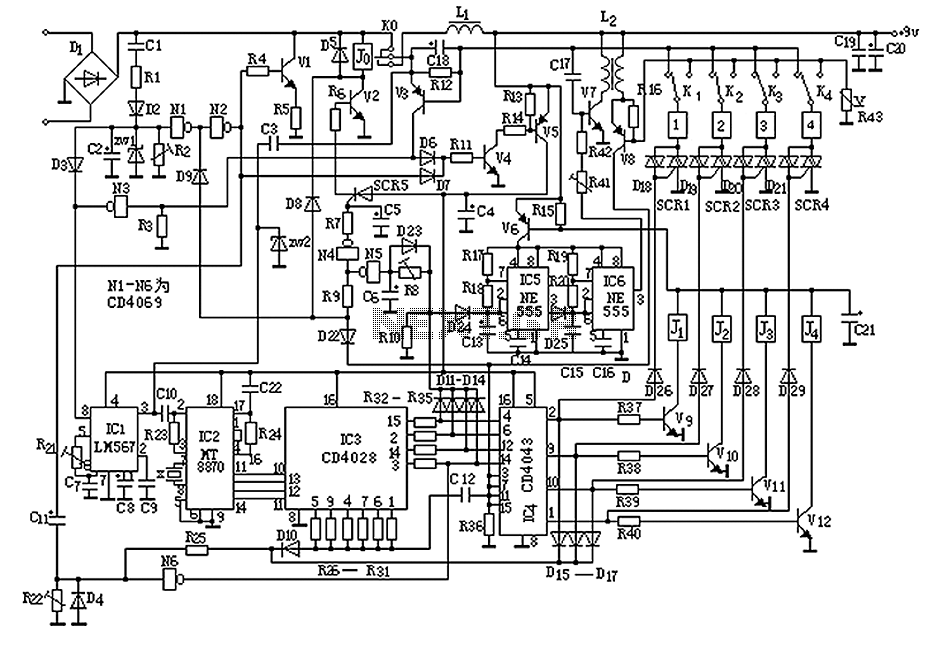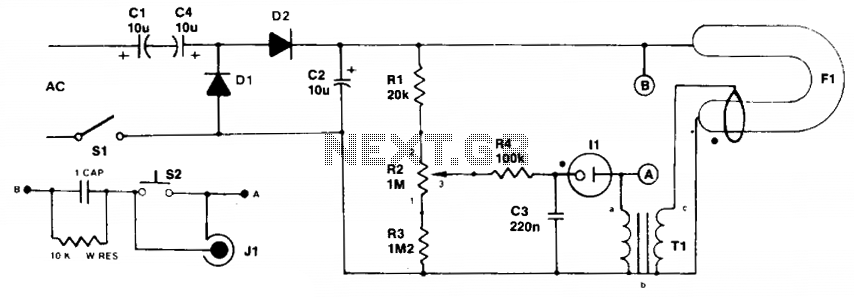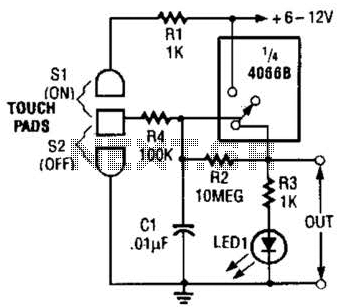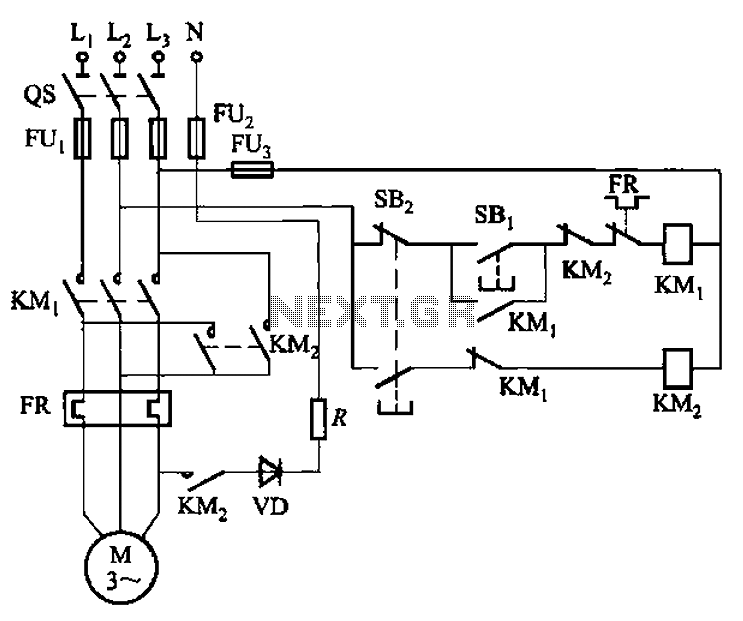
NiMH Battery Charger Circuit

A simple battery charger designed for Nickel Metal Hydride batteries that require current-regulated charging. The charger delivers a charging current of 140 mA for efficient battery charging. The power supply section includes a 0-18 volt AC 1 Ampere step-down transformer, a full-wave bridge rectifier composed of diodes D1 through D4, and a smoothing capacitor labeled C1. Current regulation is achieved through the components R1, R2, and the Epitaxial Darlington PNP transistor TIP 127. Resistor R1 limits the charging current to 140 milliampere. An LED, along with resistor R2, plays a crucial role in controlling the base current of transistor T1 and consequently its output. A voltage drop of approximately 2.6 volts occurs across the LED, which is applied to the base of T1. The emitter-base junction of T1 experiences a voltage drop of around 1.2 volts. Thus, the voltage across R1 is calculated as 2.6 volts minus 1.2 volts, resulting in 1.4 volts. The current flowing through R1 is determined by the equation 1.4 V / 10 Ω, yielding a current of 0.14 Amps or 140 milliAmps. The LED also serves as a charging status indicator, illuminating only when the battery is connected to the circuit's output and the input voltage is within the normal range.
The battery charger circuit described utilizes a transformer to step down the AC voltage, which is then rectified by the full-wave bridge rectifier. This configuration ensures that the output voltage is always positive, suitable for charging the battery. The smoothing capacitor C1 filters the rectified output voltage, reducing ripple and providing a stable DC voltage to the subsequent circuit components.
The current regulation mechanism is critical for the safe charging of Nickel Metal Hydride batteries, which can be damaged by excessive current. Resistor R1 is strategically chosen to set the desired charging current at 140 mA. The Epitaxial Darlington transistor TIP 127 is selected for its high current gain, allowing it to effectively control the output current with minimal input base current.
The LED indicator is a vital feature of the circuit, providing visual feedback regarding the charging status. When a battery is connected, and the input voltage is adequate, the LED illuminates, signaling that the charger is operational. The combination of R2 and the LED ensures that the base current to T1 is maintained at an optimal level, preventing the transistor from going into saturation, which could lead to an uncontrolled increase in charging current.
Overall, this simple yet effective battery charger circuit exemplifies fundamental electronic principles, including voltage regulation, current limiting, and visual status indication, making it suitable for safely charging Nickel Metal Hydride batteries in various applications.A simple battery charger for the Nickel Metal Hydride battery that requires current regulated charging. The charger provides 140 mA current for quick charging of the battery. Power supply section consists of a 0-18 volt AC 1 Ampere step-down transformer, a full wave bridge rectifier comprising D1 through D4 and the smoothing capacitor C1.
Current regulation is achieved by the action of R1, R2 and the Epitaxial Darlington PNP transistor TIP 127. Resistor R1 keeps the charging current to 140 milli amperes. LED and resistor R2 plays an important role to control the base current of T1 and thus its output. Around 2. 6 volts drop develops across the LED which appears at the base of T1. Emitter base junction of T1 drops around 1. 2 volts. So 2. 6 1. 2 volts gives 1. 40 volts. So the current passing through R1 will be 1. 40 V / 10 = 0. 14 Amps or 140 Milli Amps. The LED act as the charging status indicator. LED lights only if the battery is connected to the output of circuit and the input voltage is normal.
🔗 External reference
The battery charger circuit described utilizes a transformer to step down the AC voltage, which is then rectified by the full-wave bridge rectifier. This configuration ensures that the output voltage is always positive, suitable for charging the battery. The smoothing capacitor C1 filters the rectified output voltage, reducing ripple and providing a stable DC voltage to the subsequent circuit components.
The current regulation mechanism is critical for the safe charging of Nickel Metal Hydride batteries, which can be damaged by excessive current. Resistor R1 is strategically chosen to set the desired charging current at 140 mA. The Epitaxial Darlington transistor TIP 127 is selected for its high current gain, allowing it to effectively control the output current with minimal input base current.
The LED indicator is a vital feature of the circuit, providing visual feedback regarding the charging status. When a battery is connected, and the input voltage is adequate, the LED illuminates, signaling that the charger is operational. The combination of R2 and the LED ensures that the base current to T1 is maintained at an optimal level, preventing the transistor from going into saturation, which could lead to an uncontrolled increase in charging current.
Overall, this simple yet effective battery charger circuit exemplifies fundamental electronic principles, including voltage regulation, current limiting, and visual status indication, making it suitable for safely charging Nickel Metal Hydride batteries in various applications.A simple battery charger for the Nickel Metal Hydride battery that requires current regulated charging. The charger provides 140 mA current for quick charging of the battery. Power supply section consists of a 0-18 volt AC 1 Ampere step-down transformer, a full wave bridge rectifier comprising D1 through D4 and the smoothing capacitor C1.
Current regulation is achieved by the action of R1, R2 and the Epitaxial Darlington PNP transistor TIP 127. Resistor R1 keeps the charging current to 140 milli amperes. LED and resistor R2 plays an important role to control the base current of T1 and thus its output. Around 2. 6 volts drop develops across the LED which appears at the base of T1. Emitter base junction of T1 drops around 1. 2 volts. So 2. 6 1. 2 volts gives 1. 40 volts. So the current passing through R1 will be 1. 40 V / 10 = 0. 14 Amps or 140 Milli Amps. The LED act as the charging status indicator. LED lights only if the battery is connected to the output of circuit and the input voltage is normal.
🔗 External reference





